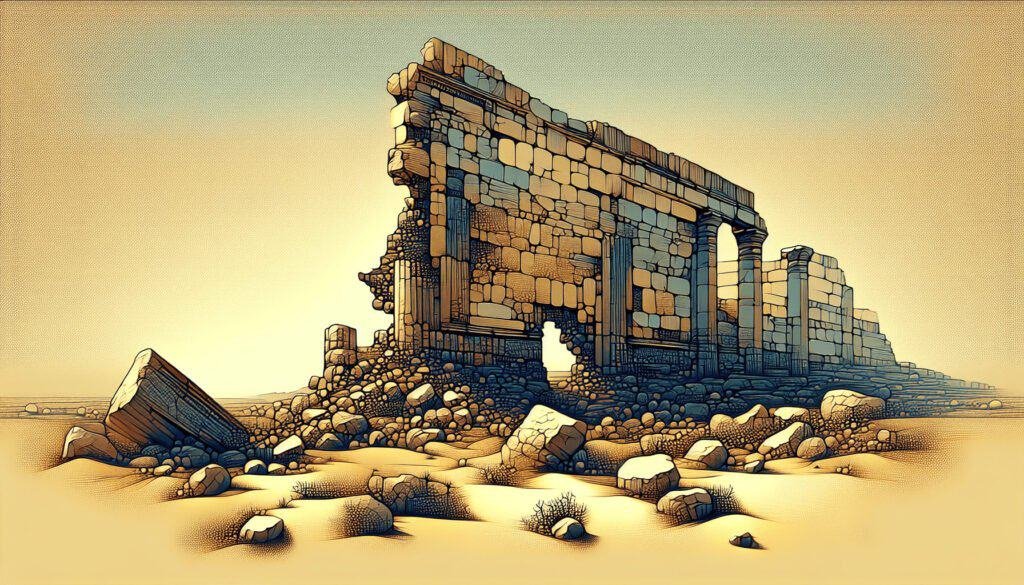What if the ancient walls of Qumran could tell stories? Stories of faith lost and found, of curses and covenants, and of the very essence of human experience intricately woven through time and faith? Let’s take a journey through history and theology, examining how the collapse of the Outer Qumran Wall may have deeper implications tied to the Covenant Curses outlined in Deuteronomy.

A Brief Look at Qumran’s Significance
You might know Qumran as the site where the Dead Sea Scrolls were discovered. This ancient settlement, located near the northwest shore of the Dead Sea, is rich in history and mystery. Established by a sect, often believed to be the Essenes, the community thrived in the Second Temple period, around the late second century BCE to 68 CE. It was here that texts were copied and hidden away—texts that reveal a deep and fervent belief in covenant theology.
What Are Covenant Curses?
Before we plunge deeper into the implications of the Outer Qumran Wall’s collapse, let’s clarify what we mean by “Covenant Curses.” The term generally refers to the adverse consequences that are outlined in the covenantal agreements between God and His people, particularly in the book of Deuteronomy. Here, blessings for obedience and curses for disobedience encapsulate the relationship dynamics between the Divine and humanity.
- Deuteronomy 28 is particularly crucial in understanding these dynamics, featuring a list of blessings for adherence to the law alongside vivid descriptions of curses for turning away from God’s commandments.
A Historical Overview of the Outer Qumran Wall
The Qumran complex was fortified by a series of walls, with the outermost serving as a barrier against potential threats, both human and natural. Archaeological studies have shown that this wall experienced significant distress over time, leading to various degrees of collapse. Understanding the physical deterioration provides an opportunity to connect it with the biblical notion of curses.
The wall’s design and structure reveal intentions of both protection and isolation. It safeguarded the community from external threats while simultaneously enforcing a culture of separation from the wider Jewish society, which they viewed as corrupt.
The Collapse: A Closer Look
When analyzing the collapse of the Outer Qumran Wall, it’s essential to consider both the archaeological evidence and its theological implications. Such collapses are not mere accidents of nature; they often evoke theological questions. Was this a judgment from God? A sign of the community’s failure to uphold its covenant?
Archaeological Evidence
Several key archaeological digs have provided insights into the state of the Outer Qumran Wall. Researchers have noted the following:
- Structural Weakness: The wall shows clear signs of deterioration indicative of inadequate construction techniques or the impact of environmental factors like erosion.
- Collapse Patterns: Evidence suggests that the wall collapsed in segments, raising questions about the kinds of pressures it endured—could these phenomena tie back to ancient curses?
Theological Implications of Collapse
You can’t just dismiss this as mere structural failure. For many scholars, the collapse offers a tangible expression of a spiritual reality. For every community, a physical wall symbolizes their relationship with the divine. Here are some points to ponder:
- Judgment and Consequence: Was the wall’s collapse a reflection of God’s judgment? If the Qumran community fell short of their covenantal obligations, could their walls have literally crumbled as a physical manifestation of spiritual failure?
- Spiritual Isolation: The very act of separating themselves from mainstream Jewish life might have attracted divine scrutiny, suggesting that isolation may not always safeguard the faithful from judgment.
Covenant Curses in Deuteronomy: A Deep Dive
Now that we’ve examined the Qumran Wall, let’s turn our attention to the covenant curses outlined in Deuteronomy. This backdrop makes the wall’s collapse all the more poignant.
The Structure of Curses in Deuteronomy
In Deuteronomy 28, you will find blessings vividly contrasted with curses, providing a dual lens on the community’s life:
- Blessings for Obedience: These include prosperity, health, and protection.
- Curses for Disobedience: They describe pestilence, loss, and even exile.
The Call to Remember
One recurring theme in Deuteronomy is the need to remember the covenant. Observance is crucial for maintaining blessings, while forgetting invites curses. Could it be that the Qumran community forgot their central mission, leading to the collapse of their protective barriers?
Psychological and Spiritual Dimensions
The idea of covenant isn’t solely academic; it carries significant psychological weight. For the inhabitants of Qumran, adhering to their covenant meant trust and hope in their communal identity. A wall that stands tall symbolizes security and faith. When it falls, what does that signify psychologically and spiritually?
Identity Crisis: The collapse could evoke a collective identity crisis. A broken wall might translate to feelings of abandonment from God or a failure to make the sacred covenant work.
Collective Responsibility: The community may have wrestled with feelings of guilt and responsibility, as they pondered what sins led to such a fate.
The Qumran Community’s Response to Curses
How did the Qumran community react to the implications of their wall’s collapse? Historical records suggest varied responses, from re-examination of communal practices to transformations in their beliefs.
Scriptorium and Literary Responses
One striking feature of the Qumran community was its emphasis on producing literature, including the Dead Sea Scrolls. After the wall’s collapse, it’s likely that they turned more intensely to sacred texts. Here are a couple of angles to consider:
Reaffirmation of Faith: The community may have seen the need to reinforce their covenant obligations through the active copying and producing of texts related to their heliocentric beliefs.
Reflections on Curses: Literary evidence reveals an introspective quality, prompting discussions around covenant curses. The community might have engaged in dialogues about the implications of their failure, ultimately addressing a collective need for repentance.
Ritual and Repentance
As the walls came tumbling down, what happened to the rituals? Were they abandoned or adapted?
Renewed Communal Practices: An emphasis on communal ritual practices and renewed commitments might have emerged as the community faced the harsh reality of their walls’ collapse.
The Role of Prayer and Supplication: Rituals of prayer and penitence could have intensified, focusing on seeking divine favor amid calamity.

Modern Reflections on Ancient Events
The implications of the Outer Qumran Wall’s collapse extend beyond academic interest; they can resonate in your life today. How do the lessons derived from this ancient history inform your understanding of faith, community, and individual responsibility?
Lessons from Covenant Theology
Covenant theology invites you to consider the ongoing relationship between divine promises and human actions. Understanding these dynamics fosters greater awareness of how spiritual practices shape community life, both ancient and modern.
Unpacking Spiritual Failures
You might find relevance in contemporary life regarding communities and their failures to uphold covenants—be they religious, social, or cultural. The Qumran community’s challenges can serve as a cautionary tale for groups aiming to maintain integrity and purpose in a tumultuous world.
Conclusion
In reflecting upon the collapse of the Outer Qumran Wall and its corresponding covenant curses in Deuteronomy, we gain rich insights that echo throughout time. Yes, a wall might fall, but the implications—spiritual, communal, and personal—can resonate deeply. The Qumran community’s experiences invite you to reflect on the significance of your own commitments and the possible consequences of straying from them.
As you contemplate the lessons from the past, consider how they might inform your journey today. A commitment to integrity, faith, and communal responsibility could ensure that your own “walls” stand tall and resilient, safeguarding your beliefs and values. This ancient narrative isn’t just history; it’s a call to conscious living, fostering a lasting connection to both faith and community.



